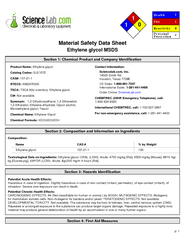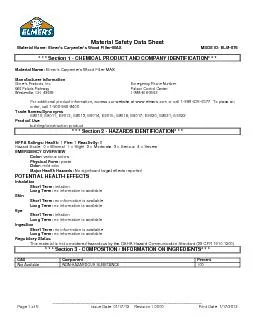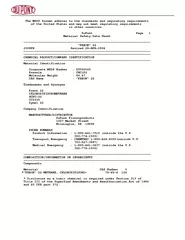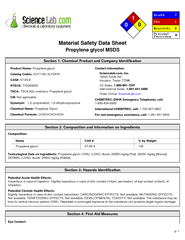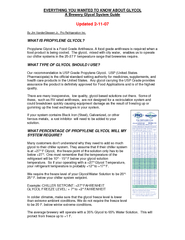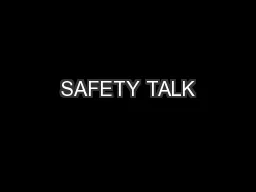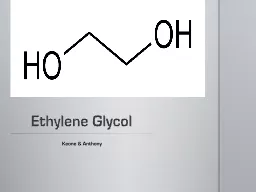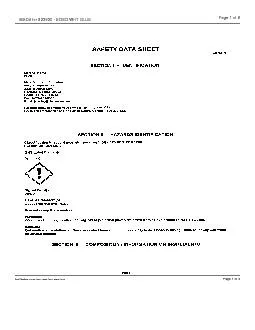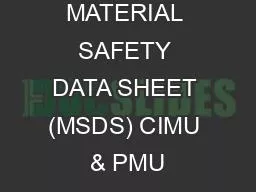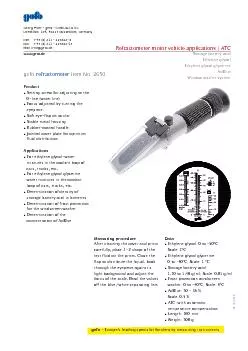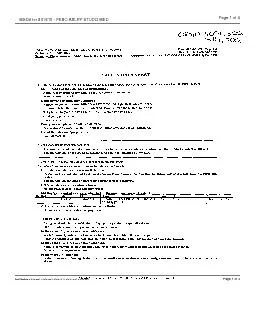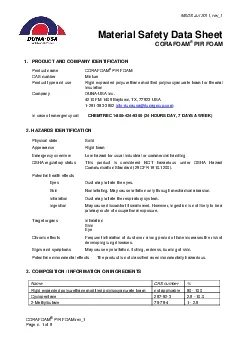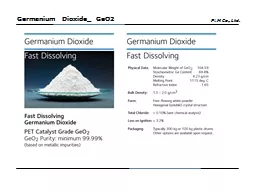PDF-Material Safety Data SheetEthylene glycol MSDS
Author : mitsue-stanley | Published Date : 2015-07-29
p 1 1 1 0 Health Fire Reactivity Personal Protection 1 1 0 C Section 1 Chemical Product and Company Identification Product Name Ethylene glycolCatalog Codes SLE1072CAS
Presentation Embed Code
Download Presentation
Download Presentation The PPT/PDF document "Material Safety Data SheetEthylene glyco..." is the property of its rightful owner. Permission is granted to download and print the materials on this website for personal, non-commercial use only, and to display it on your personal computer provided you do not modify the materials and that you retain all copyright notices contained in the materials. By downloading content from our website, you accept the terms of this agreement.
Material Safety Data SheetEthylene glycol MSDS: Transcript
p 1 1 1 0 Health Fire Reactivity Personal Protection 1 1 0 C Section 1 Chemical Product and Company Identification Product Name Ethylene glycolCatalog Codes SLE1072CAS 107211RTECS KW2975000TS. http://www.msdssource.com - MSDSSource.com is the leading provider of Online MSDS Services. Our customized sites create safer work environments, save time and help lower costs. Let us handle your MSDS Management Service today! 0000 Print Date 1172012 Section 1 CHEMICAL PRODUCT AND COMPANY IDENTIFICATION Material Name Elmers Carpenters Wood Filler MAX Manufacturer Information Elmers Products Inc Emergency Phone Number 460 Polaris Parkway Poison Control Center Westervil 2008FR DuPont Page 7 Material Safety Data Sheet ------------------------------------------------------------- p. 1 1 0 0 Health Fire Reactivity Personal Protection 2 1 0 H Section 1: Chemical Product and Company Identification Product Name: Propylene glycolCatalog Codes: SLP1162, SLP2974CAS#: 57-55-6RTECS: TY A Brewery Glycol System Guide By Jim VanderGiessen Jr, Pro Refrigeration Inc. WHAT IS PROPYLENE GLYCOL? Propylene Glycol is a Food Grade Antifreeze. A food grade antifreeze is required when a food pr Hazardous Communication #2. The hazardous communication standard uses two primary ways to communicate the chemical hazards to the employees: the label on the chemical container and the material safety data sheet (MSDS) or safety data sheet (SDS) as GHS is phased in. The following Safety . Keone & Anthony. Ethane-1,2-diol. Formula : C2H6O2 (. C. 2. H. 6. O. 2. ). Ethylene Glycol is an organic compound widely used as an automotive antifreeze and a precursor to polymers. In its regular form, it is an odorless, colorless, syrupy, sweet-tasting liquid.. Page 1 of 6 Item Numbers: 23820-1002, 23820-1004, 23820-1008 Page 1 of 6 Page 2 of 6 MSDS for #23820 - SOBO WHT GLUE Item Numbers: 23820-1002, 23820-1004, 23820-1008 Page 2 of 6 Page 3 of 6 MSDS for # For : PT Rentokil Indonesia CIMU&PMU Product Use : Rat Catcher MSDS d ate of preparation : April 6 th , 2018 1. Chemical Product and Company Identification Manufactured : PT. MEGASARI MAKMUR Address Refractometer motor vehicle applications | ATC Storage battery acidEthylene glycolEthylene glycol glycerineAdBlueWindow washer system Georg Pforr – gefo – GmbHCo.KGHo�eldstr. 104, Page 1 of 4 Item Numbers: 01610-4001, 01610-5001, 01610-5111, 01610-7001, 01610-7011 Page 1 of 4 Page 2 of 4 MSDS for #01610 - PEBO AXLRY STUDO MED Item Numbers: 01610-4001, 01610-5001, 01610-5111, 01 1 PRODUCT AND COMPANY IDENTIFICATION Product name CORAFOAM PIR FOAM CAS number Mixture Product type and use Rigid expanded polyurethane modified polyisocyanurate foam for thermal insulation Company DU P. L. M. Co., Ltd.. Germanium Dioxide_ GeO2. P. L. M. Co., Ltd.. Antimony Ethylene Glycol_ Sb2(C2H4O2)3. Product Name: Antimony Ethylene Glycol . Synonym: Antimony . Triethylene. . Golcol. (DLF ATG), . University of Cincinnati. PGY3, Internal Medicine. Osmolarity. – . osmoles of solute per . liter. of solution (. Osm. /L). Osmolality. – . osmoles of solute per . kilogram. of solvent (. Osm.
Download Document
Here is the link to download the presentation.
"Material Safety Data SheetEthylene glycol MSDS"The content belongs to its owner. You may download and print it for personal use, without modification, and keep all copyright notices. By downloading, you agree to these terms.
Related Documents

